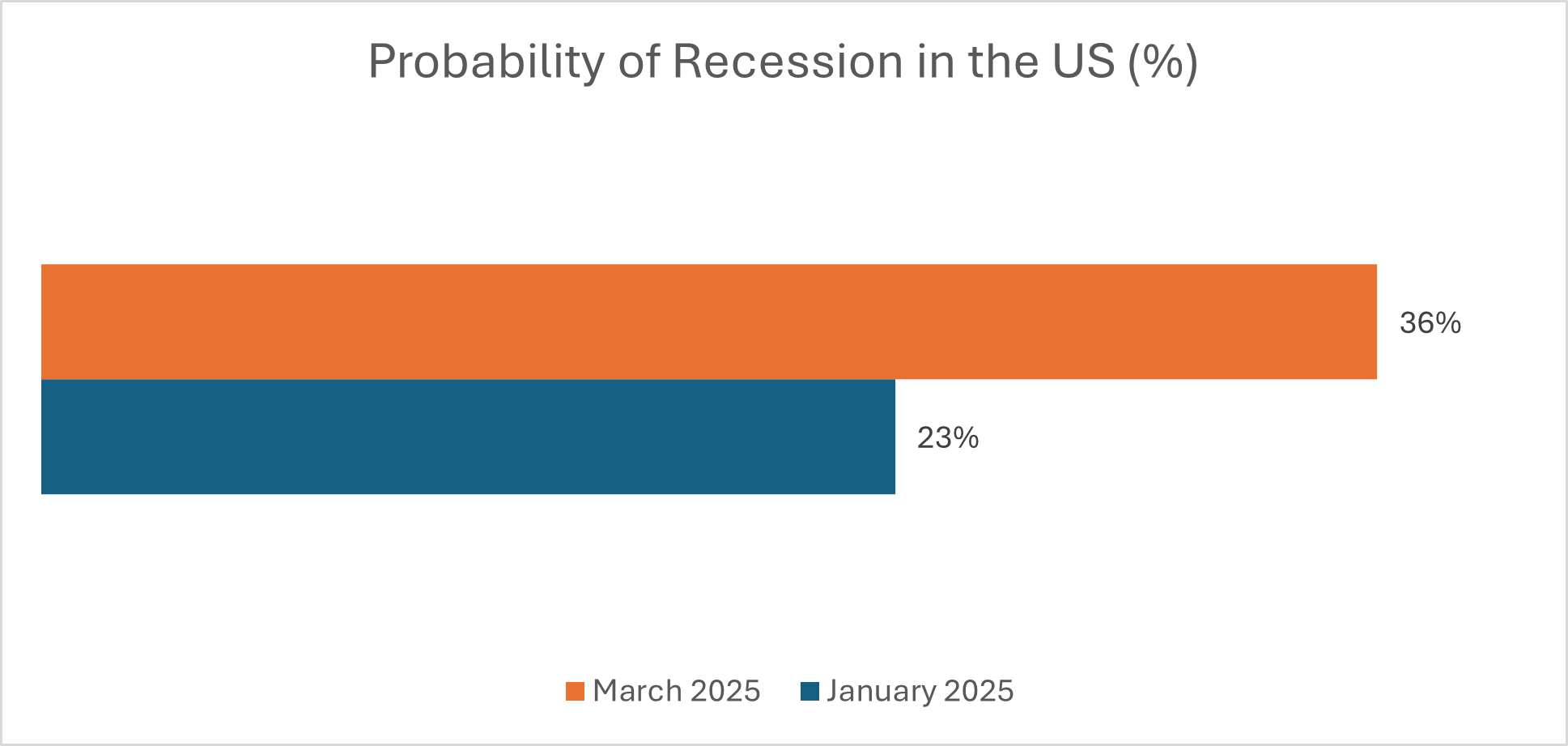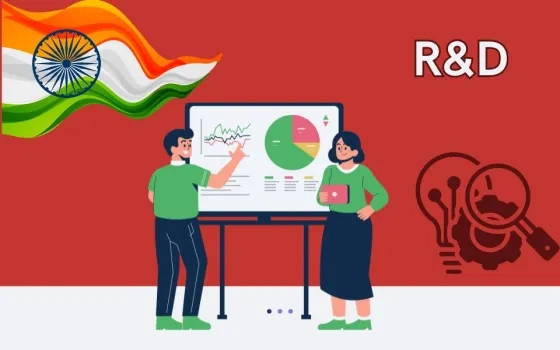The recent US government announcement of tariff measures has sparked fears of a recession, leaving the global economy on high alert. As the world's largest economy, the US has a significant impact on global growth dynamics. In this article, we'll delve into the correlation between the US economy and global growth, the rising threat of a US recession and its possible impact on global economic growth, and its implications for the Indian tech industry.
US Play in Global Growth Dynamics: The US drives world economy
The US economy is the largest economy in the world, therefore any looming turbulence in the US has a trickle-down effect on the global economy.
- US GDP stood at over $30.3 trillion in March 2025, accounting for around 26.4% of the world's GDP.
- As of 2024, the US also accounted for 15-20% of the global services trade in financial services, technology services and professional services.
- As per the World Gold Council, the US has the largest gold reserve in the world.
- The country ranks 3rd in the Global Innovation Index showcasing its innovation prowess.
- Moreover, owing to the US dollar’s role as the global reserve currency and widespread use in international transactions, fluctuations in the dollar has a widespread impact on global currencies.
Tariffs and US Recession: Going Hand in Hand?
Owing to the reasons listed above, any change in US trade policies impacts economies across the world. One such change is the recent announcement of import tariff impositions by the US government with regions including Canada, Mexico and China. The impositions include-
- A 25% tariff on most imports from Canada and Mexico, and 20% tariffs on imports from China.
- Further, 25% tariffs have been imposed on aluminium and steel imports as well as auto and auto parts.
- Additionally, semiconductors and pharmaceuticals, timber, lumber, copper and agricultural products are some goods that are under the radar for reciprocal tariff imposition on ‘Liberation Day’ i.e. April 2, 2025.
Likely Scenarios that can Play out Post US Tariff Hikes
These tariff hikes initiated by the US can trigger a change in key economic parameters, thereby enhancing the fears of a recession in the US. There are three possible fallouts of tariff hikes.
- Higher inflation leading to a hike in interest rates
Tariff hikes would lead to higher prices for US consumers. The impacted companies may pass on the increased costs of imported goods to consumers leading to higher inflation. According to the OECD's latest projections, US inflation is anticipated to climb from 2.5% in 2024 to 2.8% in 2025. To counter this upward inflationary pressure, the Federal Reserve may be compelled to raise interest rates, defying current market expectations of a rate cut. This potential rate hike could have a ripple effect, leading to reduced investments and, subsequently, decreased tech spending.
Further, higher inflation and a hike in interest rates would result in a high probability of a recession. As per a CNBC Fed Survey that polled fund managers, strategists and analysts, the probability of a recession in the US rose from 23% in January 2025 to 36% in March 2025, being at its peak since the last 6 months.

Source: CNBC Fed Survey
- Retaliatory tariffs and competitive pressures leading to a USD devaluation
An alternative scenario is that the US dollar may experience a neutralization or devaluation effect due to retaliatory tariffs imposed by other countries. This potential downturn in the dollar's value stems from the fact that retaliatory tariffs can erode foreign demand for US exports, subsequently diminishing the global appetite for the US dollar. The US government may also attempt to devalue the dollar to make US exports competitive.
- Imposition of tariffs on services
The third possible scenario could be an imposition of tariffs on services imports, including tech services. Currently, US accounts for over 62% of India’s tech services exports, translating to $140 Bn in FY25E. Services import tariffs will make not only Indian but also US tech companies who leverage India as a delivery location, uncompetitive.
Morgan Stanley estimates that the direct effect of these tariffs on US, if sustained, could boost headline PCE inflation by 0.3-0.6 percentage points, depress real consumer spending by 1.6-2.0 percentage points, and weigh on real GDP growth by 0.7-1.1 percentage points.
Impact of Tariffs on Global Economy: Slowdown Likely across the World
Together, the imposition of tariffs and the likelihood of a US recession has led to a downward revision of the overall global gross domestic product (GDP) growth projections. As per the Organization for Economic Cooperation and Development’s (OECD) interim Economic Outlook released recently, global GDP growth is projected to slowdown from 3.2% in 2024 to 3.1% in 2025 and 3% in 2026.
|
Country/Region
|
Old GDP Estimate for 2025
|
New GDP Estimate for 2025
|
Comments
|
|
US
|
2.4%
|
2.2%
|
Growth slowdown expected due to moderation of domestic demand and imposition of import tariffs
|
|
Euro Area
|
1.3%
|
1%
|
Growth to be subdued due to heightened uncertainty and weak consumer confidence
|
|
Canada
|
2%
|
0.7%
|
Growth to be subdued due to imposition of tariffs by the US
|
|
Mexico
|
1.2%
|
-1.3%
|
Mexico expected to experience degrowth due to imposition of tariffs
|
Source: OECD
These projections point towards a muted economic growth scenario, which is likely to impact key industries, including the tech industry.
Possible implications for India: Limited Impact Due to Balanced Exports Composition
According to Morgan Stanley, India's exposure to US sectoral tariffs is relatively moderate compared to other Asian economies. The most significant exposure for India is in pharmaceutical products, agriculture and food, and mineral fuels. The vehicle sector's limited exposure (0.5%) suggests that India is at a relatively lower risk from the US autos deficit perspective, unlike economies like Japan and Korea. As the US considers sector-specific tariffs, India’s balanced export composition, driven by strong domestic demand, could help mitigate potential risks.
Goldman Sachs has outlined some potential approaches for the US "reciprocal tariff" scheme. On a country-level reciprocity, where the US would raise tariffs on all imports by the average tariff difference between a specific country and the US- could lead to a 6.5 percentage point increase in US effective tariff rates on Indian imports. While on a product-level reciprocity, where the US could equalize tariff rates on individual products with those imposed by trading partners- can result in an 11.5 percentage point increase in US effective tariff rates on Indian imports.
Given India's limited export exposure to the US, accounting for approximately 2% of its GDP, and considering a 6.5-11.5 percentage point increase in US average effective tariff rates, the potential impact on domestic GDP growth would likely fall between 0.1 and 0.6 percentage points.
Possible Implications for Indian Tech Sector: Demand and Margin Pressures
The Indian tech sector experienced a stable demand environment for the first two months of Q4FY25. However, since March, there has been growing uncertainty due to changing US government policies on tariffs, leading to possible implications as outlined below-
- Impact on Client Budgets: Tariff impositions could affect client budgets due to policy uncertainty and recessionary fears, leading to delayed discretionary spending on technology.
- Focus on Cost Optimization: Clients may prioritize cost optimization, driving large deals and a robust deal pipeline.
- Margin Pressures: Tightening client budgets, increased investment needs in AI and Gen AI, and pricing pressure may lead to flat or declining margins for tech services providers.
- Cross-Currency Tailwinds: A potential decline in the US dollar against major currencies could benefit Indian tech companies.
- ER&D Players: Demand from the automotive sector may decrease for ER&D players.
- Risk of Tariff Imposition on Services: If the US includes services in tariff impositions, it could significantly disrupt the sector's competitiveness.
- Impact on Operational Costs: US GCCs in India may face higher operational costs due to tariff impositions.
As Albert Einstein said, "In the middle of every difficulty lies opportunity."
Some positive impact of the impending tariff wars could be:
- Benefits for Electronics Manufacturing: The US-China tariffs war may prompt a shift of electronics manufacturing to India, benefiting local manufacturers and creating jobs.
- Opportunities in the Semiconductor Space: The imposition of tariffs on Chinese goods may make China-based suppliers less competitive, presenting opportunities for India in the semiconductor space.
- Formation of Newer Trade Alliances: The tariffs may lead to the formation of non-US trade alliances, potentially benefiting India through new collaborations between Europe and Asia.
Is it the right time to re-evaluate long term growth strategies to future proof the Indian tech sector?
While the true impact of tariff impositions is expected to play out gradually, especially after the US government’s stance on reciprocal tariffs is clear post ‘Liberation Day’, the tech industry needs to gear up to devise a future course of action. With all eyes set on April 2, 2025, there will be five fundamental questions that stakeholders across the tech industry need to navigate post the big tariff shake-up. These include:
- Diversification beyond the US: How essential is it to diversify the business beyond geographies like the US and explore newer growth hotspots?
- Shielding from slowdown in client tech spends: How can tech companies shield themselves from slowdown in client’s tech spends?
- Diversifying supply chains: Is it cost-effective to diversify supply chains and build indigenous partnerships?
- Dynamic pricing strategies: Can technology be leveraged to implement dynamic pricing strategies, allowing companies to quickly adjust prices in response to changes in tariff rates and competitor pricing?
- Innovating and developing newer offerings: Should the imposition of tariffs be used as an opportunity to use emerging tech to innovate and develop newer offerings?





















